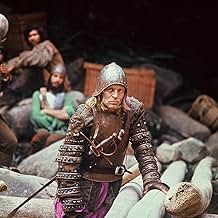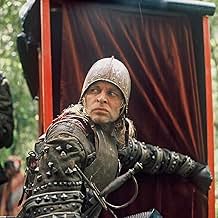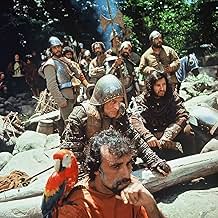Nel XVI secolo, il folle e spietato Don Lope de Aguirre conduce una spedizione spagnola alla ricerca dell'El Dorado.Nel XVI secolo, il folle e spietato Don Lope de Aguirre conduce una spedizione spagnola alla ricerca dell'El Dorado.Nel XVI secolo, il folle e spietato Don Lope de Aguirre conduce una spedizione spagnola alla ricerca dell'El Dorado.
- Regia
- Sceneggiatura
- Star
- Premi
- 4 vittorie e 3 candidature totali
Claus Biederstaedt
- Brother Gaspar de Carvajal
- (voce)
- (non citato nei titoli originali)
Lothar Blumhagen
- Don Pedro de Ursua
- (voce)
- (non citato nei titoli originali)
Heinz Theo Branding
- Don Fernando de Guzman
- (voce)
- (non citato nei titoli originali)
Christian Brückner
- Balthasar
- (voce)
- (non citato nei titoli originali)
Recensione in evidenza
AGUIRRE: THE WRATH OF GOD (Werner Herzog - West Germany 1972).
Herzog's daring and unconventional approach in film-making is something very few filmmakers can match. Due to the incredible hardships while filming on location in the Amazonian jungle, the myth surrounding AGUIRRE has almost outgrown the virtues of the film itself and over the years it has become an almost integral part when (re)viewing this film, even more so since Herzog's documentary MY BEST FIEND (1999) was released about his relationship with "best enemy" and star in many of his films, Klaus Kinski.
A mesmerizing exploration of human obsession based on the diaries of Gaspar de Varvajal, a monk who accompanied Gonzalez Pizarro (half-brother of the brutal conqueror of the Incas) and died during the expedition, the film chronicles Pizarro's 1560 Peruvian expedition in search of the legendary city of gold, El Dorado. When the expedition is faltering by the difficult terrain, Pizarro decides to send a small party ahead to determine if exploration should continue. Though Don Pedro de Ursua (Ruy Guerra) is put in charge, he is soon challenged by the ambitious fanatical Aguirre (Klaus Kinski), who against all odds wants the journey to continue, with catastrophic consequences.
One of the key elements in Herzog's work is the use of landscape and the natural surroundings. The Amazonian jungle is a key third dimension in the film and really is a green hell, threatening and unforgiven. There's no romanticism in Herzog's view of nature. The continuing sounds of the running water and the birds are just as important for the story and the despair of Aguirre's men as the ambient electronic soundtrack by the German ensemble Popol Vuh, the ultimate modern and very German pioneers in electronic music, mixing choral chants with electronic samples and organ music. To me it is simply astonishing Herzog decided to use their in a film about 16th century Spanish explorers shot on location in the Amazon and somehow it works wonderfully, a perfect blend of image and sound. Hard to identify a very important element of the "natural soundtrack": what's the name of the bird that produces this whistling shriek, that is heard almost continuously in the background and is one of the most recognizable sounds of Neo-tropical rain forests? A Quetzal?
Klaus Kinski's performance is a perfect match for Aguirre's descent into madness, eerily resemblant to Kinski's own Mad Kraut persona and well-published rampant behavior on the set and his misconduct in general actually. Watching the film for the first time with audio commentary by Herzog and he revealed many things I never heard before. One of the strangest anecdotes is not really about the film itself but is, well..truly one of the most bizarre things I ever heard.
Before the shooting started, Herzog and his crew were boarding for the plane that would bring them from Lima to Cuzco when the airplane had some technical problems. Since the airline company in question already had two or three serious accidents not long before, they decided to wait and take the next plane. Repaired or not, the plane left off anyway and crashed in the Amazonian jungle with the only survivor a young German woman, Juliane Koepcke. After weeks she finally reached a remote Indian village, malnourished, an almost fatal larval infection, close to death. Later Herzog would make a documentary about this, JULIANES STURZ IN DEN DSCHUNGEL (English title: Wings of Hope) (2000). Besides the already astonishing, many times near-fatal accidents and Kinski's impossible madman behavior, this film seemed doomed from the start, like an old curse from the Incas.
For those less familiar with Herzog's work, FITZCARRALDO (1982), also by Herzog and shot under equally horrendous conditions in the Peruvian jungle, would make a good companion piece. For Herzog's relationship with Kinski there is the interesting documentary MEIN LIEBSTER FEIND (My best fiend) (1999).
Camera Obscura --- 10/10
Herzog's daring and unconventional approach in film-making is something very few filmmakers can match. Due to the incredible hardships while filming on location in the Amazonian jungle, the myth surrounding AGUIRRE has almost outgrown the virtues of the film itself and over the years it has become an almost integral part when (re)viewing this film, even more so since Herzog's documentary MY BEST FIEND (1999) was released about his relationship with "best enemy" and star in many of his films, Klaus Kinski.
A mesmerizing exploration of human obsession based on the diaries of Gaspar de Varvajal, a monk who accompanied Gonzalez Pizarro (half-brother of the brutal conqueror of the Incas) and died during the expedition, the film chronicles Pizarro's 1560 Peruvian expedition in search of the legendary city of gold, El Dorado. When the expedition is faltering by the difficult terrain, Pizarro decides to send a small party ahead to determine if exploration should continue. Though Don Pedro de Ursua (Ruy Guerra) is put in charge, he is soon challenged by the ambitious fanatical Aguirre (Klaus Kinski), who against all odds wants the journey to continue, with catastrophic consequences.
One of the key elements in Herzog's work is the use of landscape and the natural surroundings. The Amazonian jungle is a key third dimension in the film and really is a green hell, threatening and unforgiven. There's no romanticism in Herzog's view of nature. The continuing sounds of the running water and the birds are just as important for the story and the despair of Aguirre's men as the ambient electronic soundtrack by the German ensemble Popol Vuh, the ultimate modern and very German pioneers in electronic music, mixing choral chants with electronic samples and organ music. To me it is simply astonishing Herzog decided to use their in a film about 16th century Spanish explorers shot on location in the Amazon and somehow it works wonderfully, a perfect blend of image and sound. Hard to identify a very important element of the "natural soundtrack": what's the name of the bird that produces this whistling shriek, that is heard almost continuously in the background and is one of the most recognizable sounds of Neo-tropical rain forests? A Quetzal?
Klaus Kinski's performance is a perfect match for Aguirre's descent into madness, eerily resemblant to Kinski's own Mad Kraut persona and well-published rampant behavior on the set and his misconduct in general actually. Watching the film for the first time with audio commentary by Herzog and he revealed many things I never heard before. One of the strangest anecdotes is not really about the film itself but is, well..truly one of the most bizarre things I ever heard.
Before the shooting started, Herzog and his crew were boarding for the plane that would bring them from Lima to Cuzco when the airplane had some technical problems. Since the airline company in question already had two or three serious accidents not long before, they decided to wait and take the next plane. Repaired or not, the plane left off anyway and crashed in the Amazonian jungle with the only survivor a young German woman, Juliane Koepcke. After weeks she finally reached a remote Indian village, malnourished, an almost fatal larval infection, close to death. Later Herzog would make a documentary about this, JULIANES STURZ IN DEN DSCHUNGEL (English title: Wings of Hope) (2000). Besides the already astonishing, many times near-fatal accidents and Kinski's impossible madman behavior, this film seemed doomed from the start, like an old curse from the Incas.
For those less familiar with Herzog's work, FITZCARRALDO (1982), also by Herzog and shot under equally horrendous conditions in the Peruvian jungle, would make a good companion piece. For Herzog's relationship with Kinski there is the interesting documentary MEIN LIEBSTER FEIND (My best fiend) (1999).
Camera Obscura --- 10/10
- Camera-Obscura
- 22 ott 2006
- Permalink
Trama
Lo sapevi?
- QuizDuring a particularly rowdy night of production, Klaus Kinski, irritated by the noise from a hut where cast and crew were playing cards, repeatedly fired with a Winchester rifle into it. One of the bullets took the tip of an unnamed extra's finger off. Werner Herzog immediately confiscated the weapon and it remains his property to this day.
- BlooperThe indigenous Peruvians wear clothes that were imported by Europeans in the 19th century.
- Citazioni
Don Lope de Aguirre: That man is a head taller than me. That may change.
- Versioni alternativeThe early 2000's DVD release is missing the opening shot (after the text scroll) of the clouds parting to reveal the mountains. It simply opens on the shot following the line of people descending the narrow mountain trail. It also is missing the title credits over the river water. Earlier U.S. video versions were missing these titles as well, but kept the footage so that the film had several seemingly unmotivated long shots of the flowing water.
- ConnessioniEdited into Spisok korabley (2008)
- Colonne sonoreAguirre, Der Zorn Gottes (Lacrime Di Re)
Written by Florian Fricke
Performed by Popol Vuh
Published by Edition Intro Meisel
Courtesy of Gammarock Music
I più visti
Accedi per valutare e creare un elenco di titoli salvati per ottenere consigli personalizzati
Dettagli
- Data di uscita
- Paesi di origine
- Lingue
- Celebre anche come
- Aguirre, la ira de Dios
- Luoghi delle riprese
- Huayna Picchu, Peru(mountain with stone stairway in the opening scene)
- Aziende produttrici
- Vedi altri crediti dell’azienda su IMDbPro
Botteghino
- Budget
- 370.000 USD (previsto)
- Lordo in tutto il mondo
- 37.794 USD
Contribuisci a questa pagina
Suggerisci una modifica o aggiungi i contenuti mancanti
































